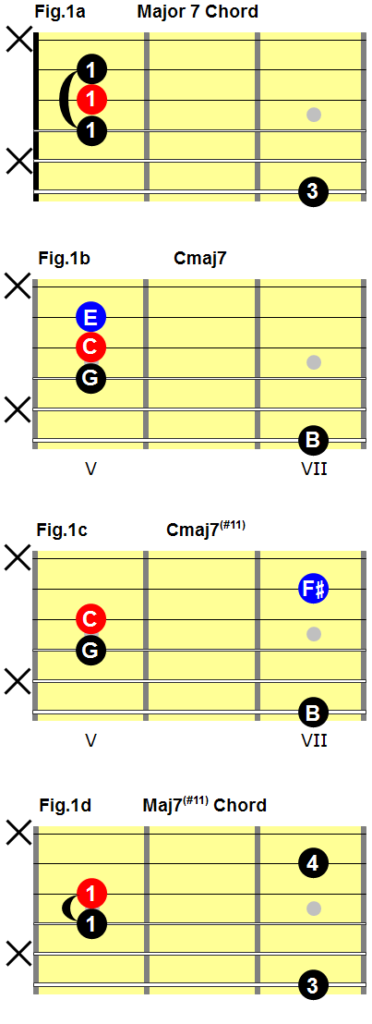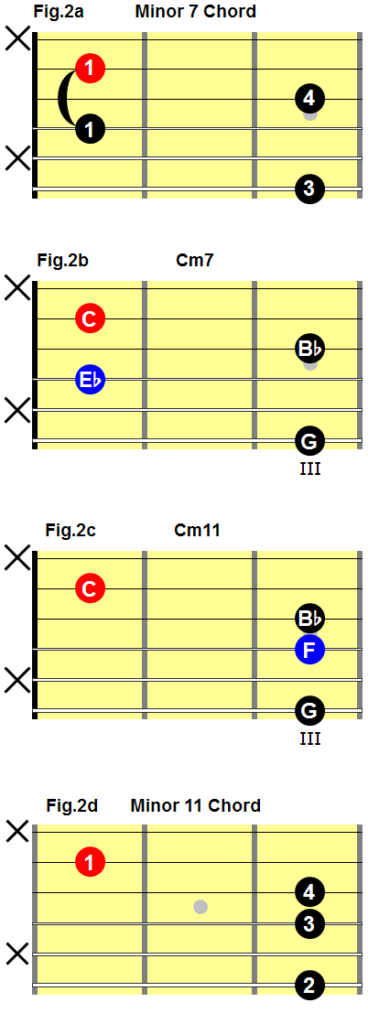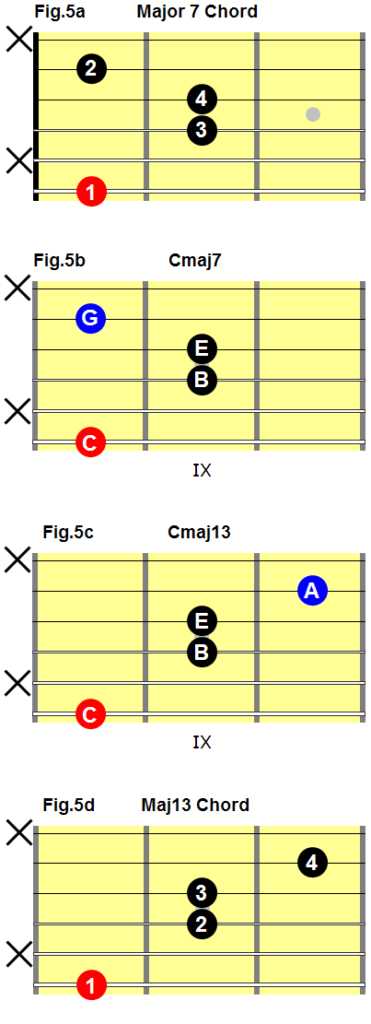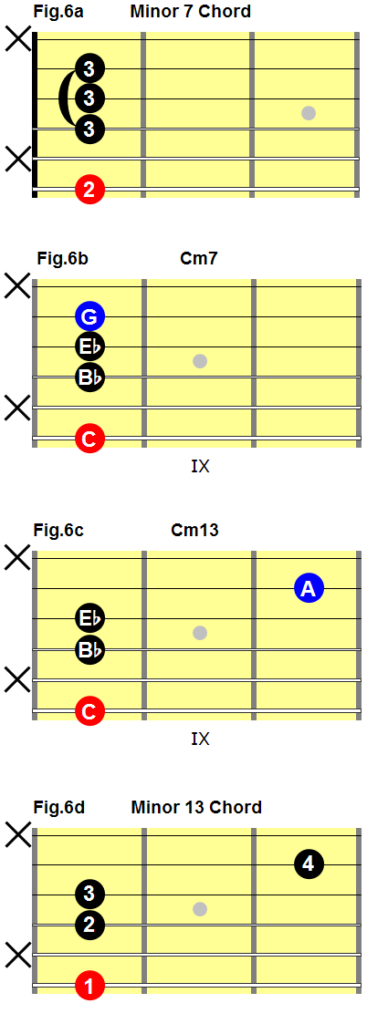My previous two posts took us through the process of altering basic seventh chord voicings on a guitar to create voicings for sixth and ninth chords as well as chords with altered fifth scale degrees.
This post will provide instruction on how to alter seventh chord voicings to create voicings for:
- Eleventh chords.
- Suspended Fourth Chords.
- Thirteenth Chords.
Eleventh and Sharp Eleven Chords
Rule: To create an eleventh or sharp eleven chord, alter the third note in a seventh chord voicing.
Creating Major Seventh, Sharp Eleven Chords: Theory
The chord formula for a major seventh chord is 1, 3, 5, 7.
The chord formula for a major seventh, sharp eleven chord is 1, 3, 5, 7, #11.
The only difference between the two chords is that the major seventh, sharp eleven chord contains an additional note, the sharped 11th scale degree.
To create a major seventh, sharp eleven chord voicing from a major seventh chord voicing:
- Locate the note in the major seventh chord that is the scale’s third degree.
- Change that note to the note that is the scale’s sharped 11th degree.
Creating Major Seventh, Sharp Eleven Chords: On a Guitar
To create a Cmaj7(#11) chord voicing from a Cmaj7 chord voicing:
- Locate the note in the Cmaj7 chord that is the scale’s third degree (E).
- Change that note to the note that is the scale’s sharped 11th degree (F#).
A common fingering for a major seventh chord is shown in fig.1a.
To play a Cmaj7 chord, place the barre on fifth fret (fig.1b).
To create a Cmaj7(#11) chord:
- Locate the E in the Cmaj7 chord (highlighted in blue).
- Change the E to an F# (fig.1c, highlighted in blue).
You now have a movable major seventh, sharp eleven chord fingering (fig.1d).
Fig.1

Creating Minor Eleventh Chords: Theory
The chord formula for a minor seventh chord is 1, b3, 5, b7.
The chord formula for a minor eleventh chord is 1, b3, 5, b7, 9, 11.
If we omit the ninth scale degree from the minor eleventh chord, the only difference between the two chords is that the minor eleventh chord contains an additional note, the 11th scale degree.
To create a minor eleventh chord voicing from a minor seventh chord voicing:
- Locate the note in the minor seventh chord that is the scale’s flatted third degree.
- Change that note to the note that is the scale’s 11th degree.
Creating Minor Eleventh Chords: On a Guitar
To create a Cm11 chord voicing from a Cm7 chord voicing:
- Locate the note in the Cm7 chord that is the scale’s flatted third degree (Eb).
- Change that note to the note that is the scale’s 11th degree (F).
A common fingering for a minor seventh chord is shown in fig.2a.
To play a Cm7 chord, place the barre on the first fret (fig.2b).
To create a Cm11 chord:
- Locate the Eb in the Cm7 chord (highlighted in blue).
- Change the Eb to an F (fig.2c, highlighted in blue).
You now have a movable minor eleventh chord fingering (fig.2d).
Fig.2

Suspended Fourth Chords
Creating Dominant Seventh, Suspended Fourth Chords: Theory
The chord formula for a dominant seventh chord is 1, 3, 5, b7.
The chord formula for a dominant seventh, suspended fourth chord is 1, 4, 5, b7.
The only difference between the two chords is that the dominant seventh chord contains the third scale degree and the dominant seventh, suspended fourth chord contains the fourth scale degree instead.
To create a dominant seventh, suspended fourth chord voicing from a dominant seventh chord voicing:
- Locate the note in the dominant seventh chord that is the scale’s third degree.
- Change that note to the note that is the scale’s fourth degree.
Creating Dominant Seventh, Suspended Fourth Chords: On a Guitar
To create a C7(sus4) chord voicing from a C7 chord voicing:
- Locate the note in the C7 chord that is the scale’s third degree (E).
- Change that note to the note that is the scale’s fourth degree (F).
A common fingering for a dominant seventh chord is shown in fig.3a.
To play a C7 chord, place your first finger on the C on the sixth string, eighth fret (fig.3b).
To create a C7(sus4) chord:
- Locate the E in the C7 chord (highlighted in blue).
- Change the E to an F (fig.3c, highlighted in blue).
You now have a movable dominant seventh, suspended fourth chord fingering (fig.3d).
Fig.3

Creating Dominant Ninth, Suspended Fourth Chords: Theory
The chord formula for a dominant seventh chord is 1, 3, 5, b7.
The chord formula for a dominant ninth, suspended fourth chord is 1, 4, 5, b7, 9.
There are two differences between the chords:
- The dominant ninth, suspended fourth chord contains a fourth scale degree instead of a third scale degree.
- The dominant ninth, suspended fourth chord contains an additional note, the scale’s ninth degree.
To create a dominant ninth, suspended fourth chord from a dominant seventh chord voicing, we need to change two notes:
- Change the third scale degree in the dominant seventh chord to the scale’s fourth degree.
- Change the root note in the dominant seventh chord to the note that is the scale’s ninth degree.
Creating Dominant Ninth, Suspended Fourth Chords: On a Guitar
To create a C9(sus4) chord voicing from a C7 chord voicing:
- Locate the note in the C7 chord that is the scale’s third degree (E).
- Change that note to the note that is the scale’s fourth degree (F).
- Locate the root note in the C7 chord (C).
- Change that note to the scale’s ninth degree (D).
A common fingering for a dominant seventh chord is shown in fig.4a.
To play a C7 chord, place your first finger on the C on the sixth string, eighth fret (fig.4b).
To create a C9(sus4) chord:
- Locate the E in the C7 chord (highlighted in blue).
- Change the E to an F (fig.4c, highlighted in blue).
- Locate the root note (C) in the C7 chord (fig.4b, highlighted in red).
- Change the C to a D (fig.4c, highlighted in green).
Fig.4

The root note (C) remains in the diagram as a point of reference but is won’t ring out.
You now have a movable dominant ninth, suspended fourth chord fingering, without a ringing root note. (fig.4d).
Thirteenth Chords
Rule: To create a thirteenth chord, alter the fifth note in a seventh chord.
Creating Major Thirteenth Chords: Theory
The chord formula for a major seventh chord is 1, 3, 5, 7.
The chord formula for a major thirteenth chord is 1, 3, 5, 7, 9, 11, 13.
If we omit the ninth and 11th scale degrees from the major thirteenth chord, the only difference between the two chords is that a major thirteenth chord includes the 13th scale degree and a major seventh chord does not.
To create a major thirteenth chord voicing from a major seventh chord voicing:
- Locate the note in the major seventh chord that is the scales fifth degree.
- Change that note to the note that is the scale’s 13th degree.
Creating Major Thirteenth Chords: On a Guitar
To create a Cmaj13 chord voicing from a Cmaj7 chord voicing:
- Locate the note in the Cmaj7 chord that is the scale’s fifth degree (G).
- Change that note to the note that is the scale’s 13th degree (A).
A common fingering for a major seventh chord is shown in fig.5a.
To play a Cmaj7 chord, place your first finger on the C on the sixth string, eighth fret (fig.5b).
To create a Cmaj13 chord:
- Locate the G in the Cmaj7 chord (highlighted in blue).
- Change the G to an A (fig.5c, highlighted in blue).
You now have a movable major thirteenth chord fingering (fig.5d).
Fig.5

Creating Minor Thirteenth Chords: Theory
The chord formula for a minor seventh chord is 1, b3, 5, b7.
The chord formula for a minor thirteenth chord is 1, b3, 5, b7, 9, 11, 13.
If we omit the ninth and 11th scale degrees from the minor thirteenth chord, the only difference between the two chords is that a minor thirteenth chord includes the 13th scale degree and a minor seventh chord does not.
To create a minor thirteenth chord voicing from a minor seventh chord voicing:
- Locate the note in the minor seventh chord that is the scales fifth degree.
- Change that note to the note that is the scale’s 13th degree.
Creating Minor Thirteenth Chords: On a Guitar
To create a Cm13 chord voicing from a Cm7 chord voicing:
- Locate the note in the Cm7 chord that is the scale’s fifth degree (G).
- Change that note to the note that is the scale’s 13th degree (A).
A common fingering for a minor seventh chord is shown in fig.6a.
To play a Cm7 chord, place your second finger on the C on the sixth string, eighth fret (fig.6b).
To create a Cm13 chord:
- Locate the G in the Cm7 chord (highlighted in blue).
- Change the G to an A (fig.6c, highlighted in blue).
You now have a movable minor thirteenth chord fingering (fig.6d).
Fig.6

Creating Dominant Thirteenth Chords: Theory
The chord formula for a dominant seventh chord is 1, 3, 5, b7.
The chord formula for a dominant thirteenth chord is 1, 3, 5, b7, 9, 11, 13.
If we omit the ninth and 11th scale degrees from the dominant thirteenth chord, the only difference between the two chords is that a dominant thirteenth chord includes the 13th scale degree and a dominant seventh chord does not.
To create a dominant thirteenth chord voicing from a dominant seventh chord voicing:
- Locate the note in the dominant seventh chord that is the scale’s fifth degree.
- Change that note to the note that is the scale’s 13th degree.
Creating Dominant Thirteenth Chords: On a Guitar
To create a C13 chord voicing from a C7 chord voicing:
- Locate the note in the C7 chord that is the scale’s fifth degree (G).
- Change that note to the note that is the scale’s 13th degree (A).
A common fingering for a dominant seventh chord is shown in fig.7a.
To play a C7 chord, place your first finger on the C on the sixth string, eighth fret (fig.7b).
To create a C13 chord:
- Locate the G in the C7 chord (highlighted in blue).
- Change the G to an A (fig.7c, highlighted in blue).
You now have a movable dominant thirteenth chord fingering (fig.7d).
Fig.7

Related Posts
Related posts include:
